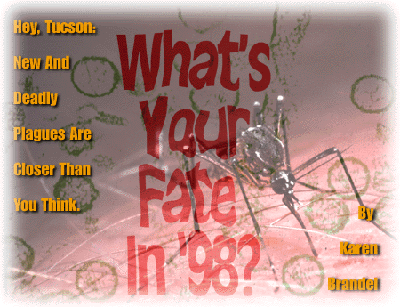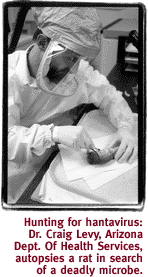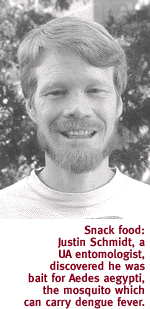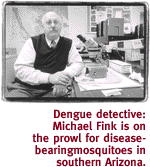
...And these four were given authority to kill with sword and
famine and pestilence.
--Revelation 6:1-8.
IN MAY 1996, a four-month-old Japanese infant underwent
routine cardiac surgery for a heart-valve defect. Despite the
pristine hospital environment, pus soon oozed from the surgical
wound. In another routine procedure, physicians whisked a cotton
swab through the pus so that the invisible scourge could be identified
under a microscope, thereby ensuring the appropriate antibiotic
would be prescribed. Clustered under the microscope, though, were
mutated bacteria doctors hoped they'd never see, and they rushed
to give the fearsome news to disease specialists around the world.
 "Staphylococcus aureus," a common bacteria found on
our skin and in our noses and throats, can cause severe infection
if it penetrates into deeper tissue or enters the bloodstream.
The antibiotic Vancomycin "is the last uniformly effective
drug available--the last line of defense--for treatment of severe
Staph infections," according to the Centers for Disease Control
in Atlanta. But the Japanese infant had within him a more evolved
strain of the bacterium, with a much thicker cell wall, and it
showed resistance to Vancomycin's powerful attacks.
"Staphylococcus aureus," a common bacteria found on
our skin and in our noses and throats, can cause severe infection
if it penetrates into deeper tissue or enters the bloodstream.
The antibiotic Vancomycin "is the last uniformly effective
drug available--the last line of defense--for treatment of severe
Staph infections," according to the Centers for Disease Control
in Atlanta. But the Japanese infant had within him a more evolved
strain of the bacterium, with a much thicker cell wall, and it
showed resistance to Vancomycin's powerful attacks.
Japanese authorities sent the bacterial strain to Dr. Fred Tenover's
lab at the CDC, which confirmed the existence of a mutated strain
of Staph having intermediate resistance to Vancomycin. Tenover
wanted to quell panic, urging colleagues not to deluge him with
questions. He stressed that the microbe had intermediate--not
full--resistance to Vancomycin (an important laboratory distinction),
and that no such cases existed in the United States.
But just a year later, in July 1997, the first U.S. case of Staph
with increased resistance to Vancomycin (now called VISA for Vancomycin
Intermediate Sensitivity Staph aureas) showed up in a hospitalized
man in Michigan.
The CDC rushed in and took nasal and hand swabs, similar to what
the Japanese had done with their infant patient. Taking no chances,
the CDC also obtained samples from about 200 people, according
to Dr. William Jarvis, of the CDC's Hospital Infections Program.
The patient, his hospital roommates, family members, visitors,
and healthcare workers were all cultured.
Why did the CDC culture such an unprecedented number of people?
"We're dealing with an evolved strain that has never been
isolated before," explains Jarvis. "We were very concerned
that healthy people that were exposed to the evolved strain could
have it colonized on their skin and spread it throughout the hospital
or out in the community."
The results showed that no one except the patient harbored the
bacteria. But barely had anyone breathed a sigh of relief when
another case popped up a month later in New Jersey. This case
was slightly different than the other two. Clearly, the bacterium
"Staph aureus" is spinning off more than one strong
version of itself, each of which is resistant to the arsenal of
antibiotics available.
Although only a few bacteria have evolved strains that are resistant
to Vancomycin, scientists have feared these would one day transfer
the needed genetic machinery into Staph, which spreads so easily
and is so deadly when it invades tissue or the bloodstream. But
tests at the CDC show that Staph is spontaneously mutating, without
any help from its microbial friends.
 Oddly, no one at the CDC is trying to find out how this bacterium
evolves, which just might give some pharmaceutical whiz a clue
as to how to mow it down. It's the Japanese who are trying hardest
to decipher the enigma of the thickened cell wall of the mutated
strain. Tenover doesn't like to be reminded of this: "Why
don't you call the Japanese?" he snaps. "They've got
every specialty you can think of working on this."
Oddly, no one at the CDC is trying to find out how this bacterium
evolves, which just might give some pharmaceutical whiz a clue
as to how to mow it down. It's the Japanese who are trying hardest
to decipher the enigma of the thickened cell wall of the mutated
strain. Tenover doesn't like to be reminded of this: "Why
don't you call the Japanese?" he snaps. "They've got
every specialty you can think of working on this."
After the two U.S. cases, Tenover issued a grim report in the
Journal of the American Medical Association, raising the specter
of quarantines, and urging physicians and public health officials
to seek the public's cooperation in dealing with these resistant
pathogens. In his report, Tenover raised the frightening possibility
of a post-antibiotic era.
"A post-antibiotic era," explains the CDC's Jarvis,
"is when antibiotics will be useless because pathogens develop
resistance. Strains evolve that are resistant and they proliferate,
illustrating a true survival of the fittest. There is no drug
after Vancomycin for treatment of serious Staph infections, and
that drug is falling by the wayside, because full resistance is
just a matter of time.
"We always assumed the pharmaceutical industry would bail
us out, and they were always one step ahead of the bugs--until
now. We need a new class of drugs, not just add-ons or variations
of old ones. What we need is not even in the pipeline. Assuming
the pharmaceutical giants are working at full capacity on this
alone, it would take about five years. What can happen in that
time we can't predict."
According to epidemiologist Ken Komatsu, of the Infectious Disease
Epidemiology Section of the Arizona Department of Health Services,
"This (VISA) is something I'm expecting to see in Arizona
as well, because of the over-use of Vancomycin."
NEARLY 30 YEARS ago, as antibiotics corralled the spread
of so many different diseases, then-Surgeon General William Stewart
proudly announced, "The time has come to close the book on
infectious diseases."
But by 1993, such a vision seemed extremely naive, as infectious
diseases surged and regained their status as the leading cause
of death world-wide. Killer infections are raging through under-developed
countries, and mutated strains of bacteria, newly discovered families
of viruses, and diseases once thought to be eradicated are all
gaining a foothold in developed countries as well. Even old, familiar
annoyances are taking on deadly forms.
For example, Streptococcus bacteria, the most common cause of
sore throats, has passed through our schools every spring and
fall for generations. But Strep can become severe, entering the
bloodstream or tissues, and there's been a mysterious increase
in severe Strep infections.
"We don't know why," says Dr. Ben Schwartz, of the
CDC. "Each year, about 8,000 to 10,000 people in the U.S.
get severe Strep, and of these, one out of seven will die."
When invasive, Strep can cause necrotizing fasciitis, which destroys
the flesh of infected people. In 1994, doctors amputated a Colorado
woman's left arm and breast because so much tissue was destroyed.
The invasive Strep can also cause a toxic shock syndrome in which
blood pressure plummets.
In 1990, Tucson saw an outbreak of invasive Strep A, according
to Ken Komatsu, of the Arizona Department of Health Services.
The number of cases increased so dramatically that the state mandated
emergency measures, requiring physicians to report every case
for an 18-month period. In October 1993, the state again added
Invasive Strep A to the list of diseases that must be reported
to the Health Department. So far, in 1997, Arizona had 110 such
cases.
As Invasive Strep A continues its mysterious increase, another
bacterium, Escherichia coli, wreaks more havoc with its mutated
strain. E.coli bacteria normally reside harmlessly in our large
intestines, but a mutated strain continues to poison hamburger
meat at fast-food restaurants. The recent contamination of frozen
meat patties at a Hudson Foods plant was preceded in 1993 by a
multi-state outbreak in the Pacific Northwest that was traced
to Jack-in-the-Box hamburgers. That outbreak affected more than
700 people with gripping abdominal pain, severe diarrhea and,
in some cases, serious kidney disease. Four children died. Yet
as early as 1981, this strain of E.coli was causing the same severe
symptoms in smaller outbreaks that didn't capture media attention,
according to Dr. Larry Slutsker, of the CDC.
 This peculiar bacterium has slyly outmaneuvered nature by stealing
a gene from a completely different bacterium--"Shigella."
And the stolen gene produces the same toxin that causes Shigellic
dysentery in Africa. In effect, some fast-food patrons sicken
with the same toxin that assaults dysentery sufferers in Africa.
This peculiar bacterium has slyly outmaneuvered nature by stealing
a gene from a completely different bacterium--"Shigella."
And the stolen gene produces the same toxin that causes Shigellic
dysentery in Africa. In effect, some fast-food patrons sicken
with the same toxin that assaults dysentery sufferers in Africa.
"How this strain of E.coli acquired that gene is the million-dollar
question," says Slutsker, who adds that it takes special
lab procedures to identify this mutated strain. Capitalizing on
the rise of E.coli-caused sickness, labs have sprung up around
the country that can identify the mutated strain.
MEANWHILE, A DREADED disease of generations ago has rebounded
with angry vigor--thanks to mutations in the bacteria that spread
it.
Tuberculosis sufferers take two drugs--usually INH and Rifampin--for
six months, according to Dr. Victorio Vaz, of the Arizona Department
of Health Services. "It's very hard to get people to take
the drug for that long, so the TB still within them mutates and
becomes resistant. I would actually prefer that they either take
the medications daily or not take them at all. When they take
it sporadically, the superbugs survive and you end up with multi-drug
resistant TB."
This year, Arizona passed a law that made it easier to quarantine
TB victims who refuse to take their medicines. Currently, the
state has one or two cases annually that require court-ordered
quarantine, but before passage of the new law, it was much more
time-consuming to do so--time in which the person was spreading
the disease to others.
Last year, Arizona saw seven cases of multi-drug resistant TB.
According to Vaz, there was much controversy over the law which
expedites the quarantine process when uninfected people are at
risk. The constitutional rights of the TB-infected person were
the focal point of arguments, but after case histories were presented,
legislators quickly understood this bacillus could easily bury
them. According to Vaz, more than 20 states have comparable laws.
And in a stunning throwback to the turn of the century, Florida
recently erected a TB sanitarium.
AND THE LIST of clear and present dangers continues to
grow here: In September 1994, Justin Schmidt, a University of
Arizona entomologist who studies the aggressive africanized honeybee,
was in the backyard of his Tucson home when he was attacked by
"a batch of nasty ankle tigers."
They were mosquitoes, not bees. "They were particularly
bad outside, but also came into the house to terrorize us. I had
experienced all sorts of mosquitoes, but these were different--they
were tiny, silent, they itched ferociously for a long time, and
they seemed to prefer biting on the ankles and feet."
Schmidt took some of the live mosquitoes to Carl Olson, of the
UA entomology lab, who could identify them under the microscope.
Olson wasted no time calling Craig Levy, of the Arizona Department
of Health Services, because Schmidt had found Aedes aegypti, a
tropical to subtropical mosquito, here in Tucson. The mosquito
is the principal carrier of yellow fever in the tropics, but it
can also transmit dengue fever, the primary risk for this area.
Dengue means "break-bone," so called because of the
high fever and profound muscle and/or bone pain associated with
the disease. Victims also complain of a headache behind the eyes,
weakness, sometimes a generalized rash, nausea, vomiting, and
diarrhea. It has a low fatality rate, unless the victim gets dengue
hemorragic fever or dengue shock syndrome.
"Dengue can be caused by four different viruses, and having
one doesn't protect you from the next one," says Levy, who
specializes in animal- and insect-borne diseases. "Sometimes
you have more than one dengue virus circulating in the same area,
and your second exposure to a different virus is what causes these
more severe manifestations."
After Olson notified Levy that Aedes aegypti was here, state
health officials, along with those from southern Arizona counties,
began their own quests for the mosquito.
 According to Levy, "We found that Aedes aegypti were pretty
well entrenched in Tucson. It's a tropical to subtropical mosquito,
and you don't think of southern Arizona as subtropical. Yet the
urban micro-environments within Tucson, where there are lots of
people, irrigated lawns with trees, and junk and clutter in the
backyards, actually create a subtropical setting within a desert
climate."
According to Levy, "We found that Aedes aegypti were pretty
well entrenched in Tucson. It's a tropical to subtropical mosquito,
and you don't think of southern Arizona as subtropical. Yet the
urban micro-environments within Tucson, where there are lots of
people, irrigated lawns with trees, and junk and clutter in the
backyards, actually create a subtropical setting within a desert
climate."
The mosquitoes are also established in Douglas, Naco, Nogales,
Green Valley and, most recently, Benson. Levy's colleague, Michael
Fink, keeps trapping throughout the state, expecting the insects
to march northward toward the pockets of urbanization in Casa
Grande and Phoenix.
If the mosquito takes a blood meal from a person infected with
dengue fever, it can then transmit the disease to the next person
it bites. "We have the vector--the mosquito--here in Arizona,"
explains Levy. "If infected people come into these communities,
you have the potential for a small outbreak. It wouldn't surprise
me if there were small outbreaks of dengue fever in areas that
have the mosquito."
"The symptoms are so severe that the infected person goes
to the doctor and is treated in the hospital," adds Fink.
"Being in the hospital removes him from the mosquitoes that
could bite him and then transmit the disease to his neighbors."
But of the 29 cases of dengue fever reported in Texas in 1995,
seven were transmitted within the state, not by traveling and
returning home with the sickness. The closest large outbreak near
Arizona's border was in Hermosillo, 150 miles south of the border,
in 1995.
"At first it was reported to be 3,000 cases," says
Levy, "but as the data kept rolling in from Sonoran Health
officials, it became more like 30,000 cases. We'll never know
for sure."
Levy emphasizes that widespread outbreaks like those in Central
and South America occur in poor communities. People have no air-conditioning,
and with open windows in summer months, mosquitoes drift inside
along with the fresh air. "The more people who get infected
and the more mosquitoes that feed on these people--you can see
an outbreak building like a rolling snowball."
"A government-spraying program won't kill these mosquitoes,"
says Fink. "We need the people of Tucson and all of southern
Arizona to police their own backyards for the small containers
that Aedes aegypti love to breed in. It doesn't breed in golf
course lakes or any major kind of standing water or pools. In
its natural state in Africa it's called a tree-hole breeding mosquito,
meaning it likes to put its eggs in small areas."
Gardeners can even promote breeding by using planters that have
an attached tray at the base--that tray will collect water and
breed the mosquitoes. Used tires are the bane of mosquito-control
efforts. Dr. Carl Mitchell, of the CDC, actually tracked the spread
of the mosquito throughout Texas in used tire shipments.
"It was widely believed that dengue and yellow fevers were
under control, but the recent spread of these diseases to new
regions has prompted the CDC to officially list them as global
microbial threats," says Mitchell.
Levy says that as unusually warm weather persists throughout
Arizona, the mosquito risks linger on as well. They keep monitoring
the big three that carry disease in the state--Aedes aegypti for
dengue fever, the Anopheles mosquito that can transmit malaria
parasites, and the Culex mosquito that can harbor encephalitis
viruses. These viruses cause infection of the brain tissue and
can result in permanent brain damage.
"You don't think of Arizona as being drenched in mosquitoes,"
Levy says, "yet we have so many species that researchers
actually come here to study them."
 IN 1993, LEVY and Fink were part of a multi-state team
trying to find out why numerous young, healthy people in northeastern
Arizona and New Mexico were falling ill with similar flu-like
symptoms and dying very quickly of respiratory distress. The medical
findings were alarming and pointed away from any new type of influenza:
Victims experienced fever, aches and chills for a brief period,
usually three days, and then quickly worsened.
IN 1993, LEVY and Fink were part of a multi-state team
trying to find out why numerous young, healthy people in northeastern
Arizona and New Mexico were falling ill with similar flu-like
symptoms and dying very quickly of respiratory distress. The medical
findings were alarming and pointed away from any new type of influenza:
Victims experienced fever, aches and chills for a brief period,
usually three days, and then quickly worsened.
As doctors consumed precious time poring over laboratory results,
trying to analyze the changes in blood samples, the victims' fluids
were abnormally shifting from their circulatory systems into their
lungs. It happened so fast that many weren't mechanically ventilated
in time.
Doctors were appalled at autopsy findings: The victims' lungs
were dense, rubbery, and usually weighed twice as much as normal.
Within the lung cavity, the lungs literally floated in a pool
of yellowish blood and water. Soon, southern Colorado had a similar
outbreak, and the Four Corners area quickly became known as a
hub of these terrifying, inexplicable deaths.
"It was many weeks of hell," recalls Levy. "We
had no idea what was causing this outbreak, and the phones wouldn't
stop ringing because everyone was in a panic."
Finally, the serum of a victim began cross-reacting with the
reagents for hantaan virus, a strain of hantavirus found in Korea.
The tests showed it was a very different, but related organism.
"Finally we had a direction. All other hantaviruses known
to exist are transmitted to people by rodents, such as mice and
rats," remembers Levy.
Levy, Fink, and the late John Doil drove to the Four Corners
area to meet with their counterparts from the health departments
of New Mexico, Colorado, Utah, the Indian Health Service and the
Navajo Nation Division of Health.
The CDC Special Pathogens Branch flew in some of their front-line
field guys to give a crash course so that everyone would be trapping
rodents, bleeding them, collecting tissue and assessing the environment
in exactly the same way. CDC officials were not about to let anyone
muddy the data on what was quickly becoming the biggest media
story of the year.
"It was scary," admits Levy, "because we had to
go into the houses where people had died from this disease and
we didn't know how transmissible it was. We didn't want to cause
neighboring households to panic, but we wore respirators if the
homes had visible rodent droppings."
They correctly suspected the disease would be transmitted through
some kind of rodent excretions that became airborne and were inhaled
by victims. In November 1993, the CDC used tissue from a deer
mouse that was trapped near a victim's home and grew the specific
strain of hantavirus that was causing so much death in the Four
Corners area. Never before seen, it was first called muerto canyon
virus and later changed to sin nombre Virus. The new disease it
caused, with its flu-like symptoms followed by rapid respiratory
failure, was named Hantavirus Pulmonary Syndrome, or HPS. The
fatality rate then was about 78 percent, and is still high at
45 percent--despite the fact that doctors are now able to recognize
the symptoms much earlier.
Arizona rodents that can become infected and pass the disease
on to humans include the deer mouse, cactus mouse, brush mouse,
piñon mouse and white-footed mouse.
"What triggered the Four Corners outbreak was El Niño
of 1992 to '93," explains Levy. The heavy rains resulted
in tremendous vegetation growth, heavy crops of piñon nuts
and seeds and plenty of insects--all extra food for rapidly multiplying
rodents. "More rodents became infected and more of these
made their way into homes, trailers and worksheds."
 How the rodents became infected with a hitherto undetected virus
is unknown. Levy says the mice probably transmit the virus by
fighting with each other, thereby passing on the infection. "What
we and the CDC noticed is that male mice were always more frequently
infected than females, and it's males who engage in more scrapping
behavior."
How the rodents became infected with a hitherto undetected virus
is unknown. Levy says the mice probably transmit the virus by
fighting with each other, thereby passing on the infection. "What
we and the CDC noticed is that male mice were always more frequently
infected than females, and it's males who engage in more scrapping
behavior."
Early on, the teams noticed that people who swept and cleaned
more often, or who planted in fields or gardens, were more likely
to contract the deadly disease than those who didn't. The researchers
wondered: Were they sweeping up the virus and inhaling it?
These days, in rural areas where there are wild mice problems,
the blanket advice is to steer clear of sweeping and avoid any
activity that creates a dust cloud. It's worth the effort to use
a mixture of bleach and water, or other liquid disinfectants,
which will kill the virus, and then mop it up.
Levy is concerned about the effects of this year's El Niño,
with predicted heavy rains that could duplicate the conditions
of the first outbreak. Rodent trapping will begin in late winter
in Tucson and other parts of southern Arizona, because the nine
cases in 1994, a year after the huge outbreak up north, occurred
in this area. As the weather warms, the trapping will move north.
"We have to see if the Hantavirus risk is rising,"
Levy says. "The idea is to find the disease before it finds
the people."
Since the Four Corners sin nombre virus was discovered, it has
caused the same deadly disease in Canada. HPS has also been caused
by newly discovered hantaviruses in Louisiana, Florida, and New
York--all with different rodent carriers. The CDC also was flooded
with reports of the deadly "Four Corners" disease caused
by yet different hantaviruses in Argentina, Brazil, Chile, Paraguay
and Uruguay, making the newly discovered Hantavirus Pulmonary
Syndrome a pan-hemispheric disease.
ALL THE EVIDENCE on newly discovered viruses, and on mutated
and stronger bacteria, is funneled to officials of the CDC--the
true bloodhounds of disease-tracking. Where there's a suspicious
organism or a strange trend in disease patterns, they never fail.
But CDC guys like Jarvis, familiar with the devastating plagues
of yesteryear, are increasingly nagged by imponderables: What's
really going on in the world of pestilence; and how likely is
it that we'll find timely cures?

|





